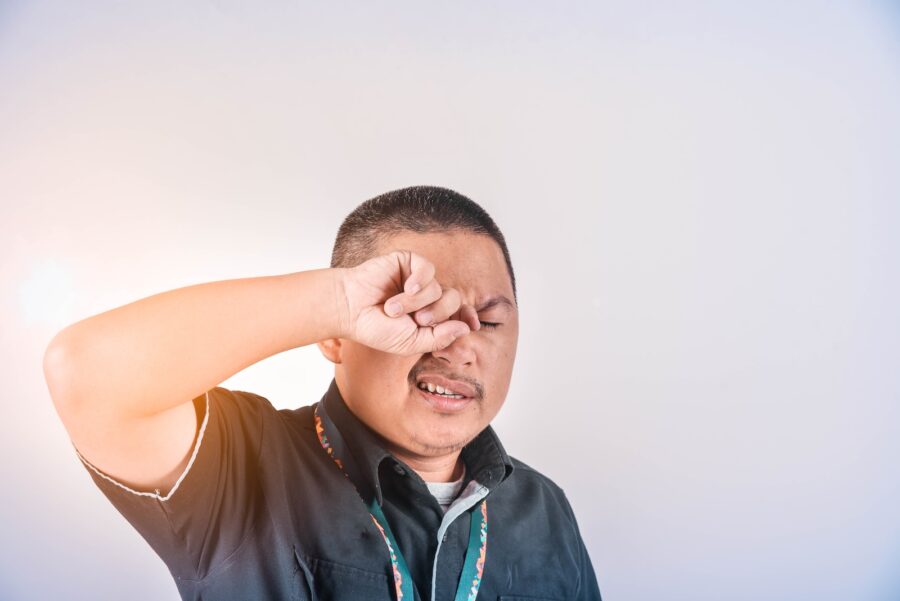Excessive blinking could be a symptom of various issues, some of which may require a trip to your GP.
As part of a recent study Vision Direct looked at blinking patterns and has asked Nimmi Mistry, professional services optician at Vision Direct, to share what excessive blinking could indicate.
Eight possible causes of excessive blinking
- Hay fever
Although there’s no cure or prevention for hay fever, there are several treatments which can lessen the impact, including antihistamines, Vaseline under your nostrils to stop pollen getting into the nasal passage and wraparound sunglasses to prevent pollen reaching your eyes. If you suffer severely from hay fever symptoms, private clinics offer treatments such as a Kenalog injection which relieves most if not all symptoms for the 6-month period.
- Dry eyes
Dryness can lead to eyes feeling sore, watery, and gritty. Your tear film has three layers: fatty oils, aqueous fluid, and mucus, all of which combine to help keep the surface of your eyes sufficiently lubricated, clear and protected. Problems with any of these layers can cause dry eyes and as a result, increased blinking to soothe these symptoms.
- Corneal abrasion (or other eye injury)
A corneal abrasion is a small scratch on the cornea. Common causes include a fingernail scraping the eye, getting grit in the eye (particularly if the grit is rubbed in further) and poor technique when inserting and removing contact lenses.
- Conjunctivitis
Conjunctivitis, also known as pink eye, is an inflammation or infection of the conjunctiva, which is the thin, mucus membrane that covers the white part of the eye and lines the inner surface of the eyelid. It can affect one or both eyes and is a common condition that can occur in people of all ages.
- Blepharitis
Blepharitis causes an inflammation of the eyelids that leads to, among other things, intermittent blurring of your vision, redness of parts of the eyelids and itching.
- Eye strain
Eyestrain, also known as asthenopia, is a condition characterised by discomfort or fatigue in the eyes. It typically occurs after prolonged periods of visual activities that require intense concentration, such as reading, using a computer or smartphone, or driving.
Eyestrain can manifest as a variety of symptoms, including eye fatigue, dryness, blurred vision, headaches, and, of course, excessive blinking.
To help alleviate these symptoms it’s important to take regular screen breaks, the 20-20-20 rule can be good for this, ensure your work set up adheres to DSE regulations and introduce artificial tears into your daily routine.
- Vision problems
Undiagnosed visual problems can also cause someone to excessively blink as the eyes try to focus and become strained as a result. If you’re finding it more difficult to see long distance or read up close, then it’s recommended that you see an optician for an eye test.
It’s important to have an eye test every two years, but, if you’ve been experiencing any of the symptoms above for a pro-longed period, it’s essential to see an eye care professional as soon as you can to eliminate any visual complications.
- Fatigue
When we’re tired, the muscles responsible for controlling eye movement and maintaining focus may become fatigued. Blinking can help momentarily relieve any discomfort, which is partially why blinking increases when we’re tired.
Fatigued eyes usually caused by pro-longed screen work and lack of sleep can aggravate dry eyes. Blinking helps spread tears across the surface of the eye, providing moisture and alleviating symptoms of dryness.
Vision Direct have developed a tool called the “the blinking test” that encourages users to click a button every time they blink for the course of one minute. At the end it will tell you how many times you blinked and how that measures up against the average blinking pattern – letting you know if your blinking pattern falls within the normal range or not.
Joanne is the editor for Workplace Wellbeing Professional and has a keen interest in promoting the safety and wellbeing of the global workforce. After earning a bachelor's degree in English literature and media studies, she taught English in China and Vietnam for two years. Before joining Work Well Pro, Joanne worked as a marketing coordinator for luxury property, where her responsibilities included blog writing, photography, and video creation.



